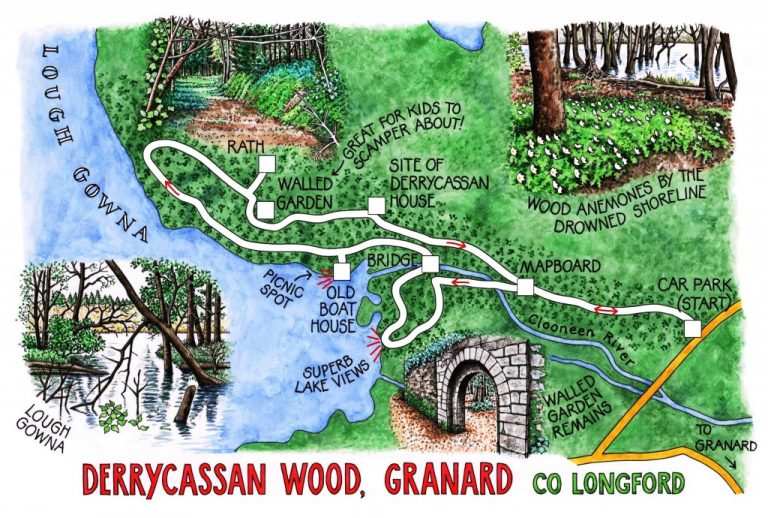Irish Independent – WALK OF THE WEEK – Christopher Somerville
19 June 2010
63. Derrycassan Wood, Granard, Co. Longford

It was one of those glorious, sunny, breezy evenings out in rural County Longford when the chaffinches are really putting their backs into their singing and you don’t believe there ever was such a thing as winter. The sinking sun brilliantly lit the gorse along the edges of Derrycassan Wood and sent dusty fingers of light filtering between the spruce trees. It touched the fast-running Clooneen River into a sparkle, and jewelled every wind-ruffled wavelet on Lough Gowna with a fiery diamond tip. As we squinted out from the viewing area over the brushy trees of Cygnet Island, Jane and I found our eyes watering with sun and wind.
Even though it was late afternoon, plenty of people – family groups, couples out for an after-work saunter – were wandering the pine-scented paths. Derrycassan Wood is set up for strollers, idlers, dawdlers and tiny scurrying kids. The paths are flat-surfaced, there are picnic tables under the trees, and the mapboard near the entrance tells you just enough about what to look out for to whet your appetite. There are three waymarked walks – Nature Trail, Walled Garden Walk and Main Avenue Walk – and we decided to roll them all into one, a decent couple of hours’ worth.
Derrycassan Wood has grown up over the past half-century around the remains of Derrycassan House and its grounds, seat of the Dopping Hepenstal family. All kinds of complications swirled about the family during the 19th century – a disappointed father who disinherited his son, internecine lawsuits, dependent spinster sisters who wouldn’t let their brothers sell property, and so on. In 1929 the Dopping Hepenstals sold the place to a timber merchant, and were probably relieved to get rid of it.
After days of rain, Lough Gowna was so full this evening that its shoreline lay drowned. Alders and birches stood footed in water. Clumps of wood anemones shone palely under the larches and firs, their delicate faces turned inward for the night. Coot squawks and the lowing of cows came across the lake, and the squeal of children playing chase through the trees.
There’s something tremendously triste and nostalgic about the ruined features of old landlord estates such as this, silently crumbling to dissolution at the heart of so many of today’s Coillte woodlands. Down on a miniature cove we found the foundations of the Dopping Hepenstals’ old boathouse, its back wall a cliff of natural rock, its concrete buttresses cushioned with mosses and ferns. The path led on above the lake, with glimpses of the long green back of Inch Island coming and going between the trees; then it doubled back on itself to bring us to the walled garden of Derrycassan House. The garden was not laid out in a conventional rectangle, but followed a curvy outline, its sinuous wall pierced with ornate gateways, one arched, another pointed, a third square. We entered through an arch and followed a path through a wilderness of scrub trees, past tumbledown alcoves and overgrown benches – a wonderful creation, fast being swallowed by inexorable nature.
The three-storey mansion that lay beyond was demolished in the 1930s. Its stones, some of which – stories say – originally belonged to a monastery on Inch Island, were themselves reused to build a church nearby. All that’s left is a fragment of sunken wall among a thick tangle of rhododendrons.
High up the hill above the kitchen garden lies the piled circular rampart of a rath, a hundred paces across, hazed with bluebells, thickly studded with crooked old hazels and tall firs that were sighing to themselves, a bitter-sweet air on the evening breeze. Of course I’m not a fanciful man – but if I were, I might have suspected the presence of Derrycassan’s ancestral inhabitants, gathered at the rath in this beautiful dusk to whisper a lament for human folly.
WAY TO GO
MAP: OS of Ireland 1:50,000 Discovery 34; downloadable map/instructions (highly recommended) at www.discoverireland.ie/walking.
TRAVEL:
Rail (www.irishrail.ie): Longford or Edgeworthstown (c. 12 miles)
Bus (www.buseireann.ie): 111 Dublin-Athboy-Granard (7 miles)
Road: From Granard, R194 Longford road; in a few yards, right (‘Lough Gowna, Arvagh’) for 3½ miles; left at crossroads (‘Derrycassan Wood Walks’) to parking place on right.
WALK DIRECTIONS: From car park, follow track for ½ mile to mapboard. Left across Clooneen River; right up track to T-junction. Left to Lake Viewing Area; continue round gravelled path – pass bench and turn left along woodland path, then left across Longford Avenue Bridge. Left along forestry road. Bear left (‘summer house, boat house’) to see the ruins. Back on the main track, turn left and follow it for ¾ mile; then turn uphill away from lake at ‘Mapboard 1.5km’ sign. In ¼ mile, left (‘Ringfort’) to circle rath and return to upper track. Turn right down path opposite (‘Walled Garden Ruin’); follow paths through walled garden, and on to site of Derrycassan House. Continue down track to car park.
LENGTH: 4 miles: allow 1½-2 hours
GRADE: Easy
RATINGS: 3 buggies, 1 wellies, 1 binoculars, 1 mountain slopes
DON’T MISS … !
• superb lake views from viewing area
• tree-smothered rath
• ruins of walled garden and Derrycassan House
REFRESHMENTS: Picnic by the lake
ACCOMMODATION: Viewmount House, Longford (043-334-1919, www.viewmounthouse.com) – very comfortable country house and restaurant
WALKING in IRELAND: Walking tour operators, local walks including Discover Ireland’s National Loop Walks, walking festivals throughout Ireland: www.discoverireland.ie/walking; www.coillteoutdoors.ie
INFORMATION:
Longford Tourist Office: Market Square, Longford (043-334-2577; www.longfordtourism.ie)
csomerville@independent.ie